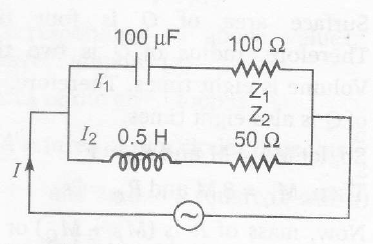Answer:
Option A,C
Explanation:

Circuit I
$X_{C}=\frac{1}{\omega C}=100 \Omega$
$\therefore$
$z_{1}=\sqrt{(100)^{2}+(100)^{2}}=100\sqrt{2} \Omega$
$\phi_{1}=\cos^{-1}\left(\frac{R_{1}}{Z_{1}}\right)=45^{0}$
In this circuit current leads the voltage
$I_{1}=\frac{V}{Z_{1}}=\frac{20}{100 \sqrt{2}}=\frac{1}{5 \sqrt{2}}A$
$V_{100 \Omega}= (100) I_{1}=(100) \frac{1}{5 \sqrt{2}}V$
$=10\sqrt{2}$V
Circuit 2
$X_{L}=\omega L=(100)(0.5)=50 \Omega$
$Z_{2}=\sqrt{(50)^{2}+(50)^{2}}=50\sqrt{2}\Omega$
$\phi_{2}=\cos^{-1}\left(\frac{R_{2}}{Z_{2}}\right)=45^{0}$
in this circuit voltage leads the current
$I_{2}=\frac{V}{Z_{2}}=\frac{20}{50\sqrt{2}}=\frac{\sqrt{2}}{5}$ A
$V_{50\Omega}=(50)I_{2}=50\left(\frac{\sqrt{2}}{5}\right)=10\sqrt{2}V$
Further $I_{1}$ and $I_{2}$ have a mutual phase difference of $90^{0}$
$\therefore$ $I=\sqrt{I_{1}^{2}+I_{2}^{2}}=\sqrt{\frac{1}{50}+\frac{4}{50}}=\frac{1}{\sqrt{10}}$
=0.3 A